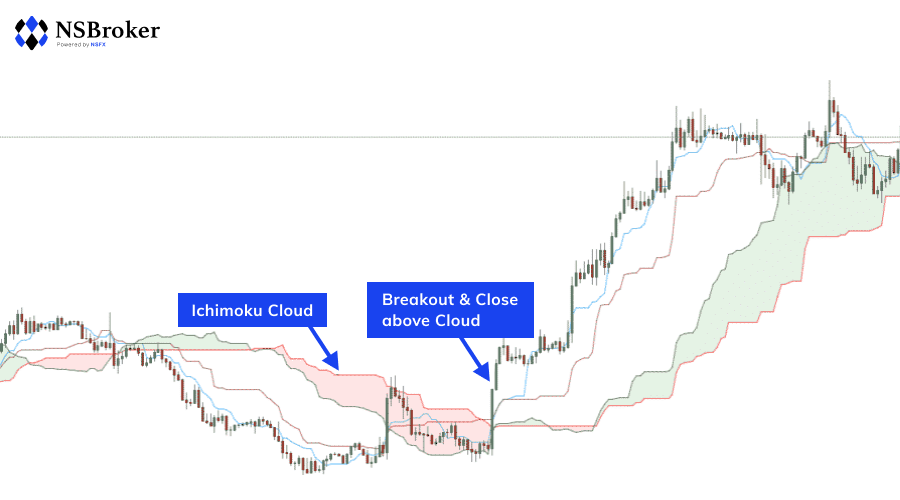How to Earn Fast with the Ichimoku Strategy

Ichimoku strategy is best used as a system of analysis of technical data for market evaluation. It offers exchange clues of unequal values and can be helpful in determining the loss risks of exchange. Although pretty basic from a first glance, the system allows you to detect some rather in-depth vision of what your plan of action on the market should be. We are going to tell a bit more about its origin and mechanics for you to be able to apply it to your next trade as soon as possible.
The system is a method of chart visualization and data analysis developed in Japan. It was first announced in 1969. Now that so much time has passed it can be stated with confidence that the strategy has proven itself effective. An interesting fact about this approach is that its name pretty much sums up the course of action behind it. Ichimoku is “a quick glance”, Kinkou is “balance” and Hyo is a “chart”. The purpose of this method is the determination of the further trend of rate changes. This helps to understand when to take on or leave a trade based on the movement tendency.
After all, this is all many of us are looking to find out when entering the market. When is the right moment and how can you be sure? Let’s look closer at the benchmarks you will need to use in order to apply this strategy. The first and most widely used would be the Ichimoku Cloud indicator. It has proven itself effective to millions of traders and is even commonly used outside of this strategy. We are going to review each component of the cloud separately and learn how to use each lead they provide.
The Ichimoku Hinko Hyo is a progression benchmark necessary to deduce the current course of the market.
It is made up of five points that provide exchange clues for you to use to your advantage.
- The Conversion Line(Tenkan-Sen) represents the middle of the last 9 candlesticks.
- The Base Line (Kijun-Sen) shows the middle of the last 26 candlesticks.
- The Lagging Line (Chiou Span) lags behind the price and is supposed to be 26 points behind.
- The Leading Span A (Senkou Span A) represents the middle point between Tenkan-Sen and Kijun-Sen. This is the faster one of the cloud boundaries and it is placed 26 points ahead.
- The Leading Span B (Senkou Span B) should be found in the midpoint of the last 52 bars. It is the slower boundary that is placed 52 points ahead.
Last, but not least, there is the Closing Price (Chikou Span) is placed 26 days in the past.
It might seem like a lot, but seeing all these lines on the chart makes much more sense. All you have to do is find out if the Leading Span A or B is higher at the moment.
Once you have everything from the above covered, the cloud comes in. Things actually get easier from here: if Senkou Span B is above A, a conclusion can be made that the rate progression is rising, and the graph will be green. In an opposite case (with a Senkou Span A above B) the asset must be moving against the trend, and the graph will be red in this scenario. All in all, you just need to take a look at the cloud colors to understand the market’s current tendency.
Some basic chart suggestions include an uptrend (with the rate below), a downtrend (with the rate above), and consolidation (with the rate in the middle of the cloud). Bearish and bullish trends can, of course, be of different levels of intensity. They are based on the following factors: how close the price shift, the Lagging Line, and the crossover are to the cloud.

Although often juxtaposed to other basic charts due to its countless lines, the Cloud chart movement appears more intense in its ventures of detecting changes. The dynamic between Leading Spans A and B gives grounds to determine a fall or a rise. Both, the shade and the volume of the cloud are important factors for this. If it is of insignificant size, whatever the tendency, it will not be prominent.
This Cloud is useful for anyone making quick trades. Combined with other technical benchmarks it can provide interesting data useful for numerous other strategies with different intervals. Again, we advise using the simplest approach possible if you are only just starting out. Overcomplicating things for yourself might spoil your learning experience or even discourage you from trading altogether. Take small steps, one at a time. Once you feel like you’ve got a handle of things and you are getting bored, move on and add something on top of your strategy. Many will say that the hardest thing about using this strategy is the patience it requires. After all, it is necessary to wait a lot before the most promising trading clues show. Let’s see how all this information can be applied in your next trade.
The goal of the Ichimoku Cloud is to keep you on the bright side of things for as long as a switch to the opposite does not take place. Considering all the nuances, this Cloud’s best match is swing trading. This pair ensures maximum potential profit and minimum risks involved. Therefore, we strongly recommend getting started with swing trading in order to best master the strategy. Once you are competent enough, there is nothing stopping you from trying out other combinations and techniques.
First, wait for the price to break and close above the cloud. This is a bullish signal that warns you about a forming uptrend. The cloud will be emphasizing the anticipated reverse points levels that consist of several layers. Make sure the layers go deep enough for you to examine and make conclusions about the situation. Next, wait till Tenkan-Sen breaks above Kijun-Sen. Once this happens, you can confidently enter a trade. The perfect conditions for opening a trade would involve the moment of the crossover at the entry of the following candle. Once you detect that moment, go in and determine your stop loss.
After a lot of research, it was determined that the best stop loss option is below the bolt candle. This not only lowers your risks of losing money but also allows you to trade along with the market’s flow. For maximum security, opt out right when a new crossover takes place towards the other way. And, finally, when Tenkan-Sen traverses the Kijun-Sen below, close the trade and gather the returns. On the other hand, you can hold off till the price breaks underneath the cloud, but this enhances your risks of losing profit. This is where patience comes in handy one more time.
The Ichimoku Strategy is, without a doubt, quite different from anything else you can come across when inspecting countless approaches to technical analysis. Nonetheless, the technique has been proving itself useful over a few decades. If you are having a hard time determining trends, try applying the Cloud technique, and see what happens. This strategy is a perfect way for someone who feels lost on the market to feel like they have an understanding of what is happening and how it can be interpreted. It gives you the tools to use for paving your way through the market, learning, and making a profit in the meantime.










